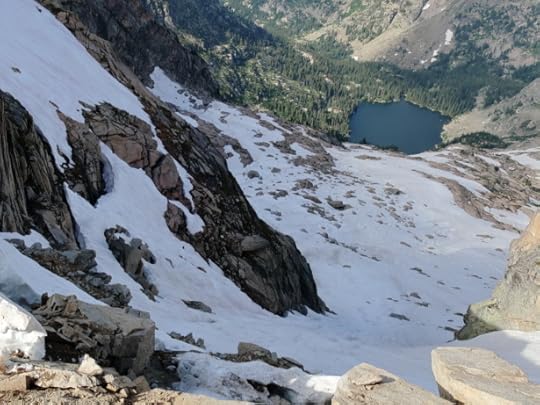Words of caution: FKT’ing or “running” the Pfiffner Traverse


Looking down the steep Northeast Gully, the most technical section of the Pfiffner Traverse. Snow lingers until August in a normal year, and is better than what’s underneath: loose rock and dirt.
In a recent photo essay in Trail Runner, Sunny Stroeer gave a hearty endorsement of the Pfiffner Traverse, for which she set a 55-hour fastest known time (FKT) last summer:
“The Pfiffner Traverse is a mountain runner’s dream: miles of smooth, gentle singletrack that flow through high mountain meadows and across infrequently traveled passes along the Continental Divide’s alpine beauty. Stretches of exposed, soft alpine tundra switch off with fragrant forest and lush wetlands defined by sparkling streams and colorful explosions of wildflowers. During the height of summer, majestic elk graze peacefully above treeline here. Crystal-clear alpine lakes, waterfalls, views for days and solitude: this run has it all.”
I’m flattered by her description of the route, which is more lyrical and poetic than anything I’ve written about it, but I’m nervous that her article oversells it to Trail Runner’s audience. Sunny writes, “I am convinced that this crown jewel of the Colorado Rockies has the potential of being ultra running’s next great test piece, nestled in difficulty squarely between the Grand Canyon’s marquee Rim-to-Rim-to-Rim and the superhuman peak bagger’s linkup that is Nolan’s 14.”
I’m not as convinced.
Yes, the Pfiffner Traverse is squarely in the wheelhouse of a short list of mountain endurance athletes like Jared Campbell, Joe Grant, Heather Anderson, and obviously Sunny. But for trail and ultra runners with less robust skill sets (i.e. most of them), it’d be an ill-suited undertaking. It’s nothing like Rim to Rim or a conventional ultra marathon course.
As a baseline, let’s compare the difficulty of the Pfiffner Traverse with one of the most difficult ultra marathons in the US, the Hardrock 100. Both routes:
Are very high, with elevations usually between 10,000 to 13,000 feet above sea level;
Have extreme vertical change per distance — 660 feet per mile on Hardrock, and 750 vertical feet per mile on the Pfiffner; and,
Subject to violent thunderstorms, unreliable cell service, and run-ins with antlered wildlife.
But the Pfiffner is grades harder than Hardrock. In some respects, it’s also more difficult than Nolan’s 14:
1. Route access
Milner Pass and Berthoud Pass serve as the northern and southern termini of the Pfiffner, and both are crossed by paved highways. But in between there is only one vehicle-accessible spot, 16 miles from the southern terminus via a gravel road.
Otherwise, the route can only be accessed on foot or stock (no bicycles), usually by hiking in about 8 miles and up 2,500 vertical feet. Even with a multi-person and multi-vehicle support crew, the Pfiffner demands self-reliance.
2. Off-trail
Forty percent (31 miles) of the 76-mile Pfiffner is off-trail. To successfully and safely navigate these sections, you must be able to expertly read a map, use a compass, utilize your altimeter, operate a GPS, and identify the line of least resistance between two points — not just run between course markings, or take out your map only at trail junctions.
3. Technical difficulty
When it’s not off-trail, the Pfiffner is almost always on singletrack — once, it follows a jeep road for a mere quarter-mile. As a result, almost every mile is hard-won — there are only a few stretches where you can disengage and auto-pilot.
And some sections are particularly difficult, on par with the worst of Nolan’s. They involve tedious travel through blowdown-filled spruce/fir forests; risky rock-hopping across talus, rockfall, craggy ridgelines, and blockfield; and scrambling up steep snowfields (up to 40 degrees) or slabs. It’s a no-fall zone, and bailouts and rescues will not be fast.
A more reasonable approach
Not entirely deterred? If you’re a trail or ultra runner who would like to take on the Pffifner, my recommendation is to:
1. Backpack it — or, if it will make you feel better about yourself, say that you’re “fastpacking” it. Carry overnight gear, maintain a sustainable pace, and budget 7 to 10 days.
2. Take on just a section of it. The Pfiffner Traverse Guide includes maps, a route description, and mileage chart for seven recommended loops.
The post Words of caution: FKT’ing or “running” the Pfiffner Traverse appeared first on Andrew Skurka.



